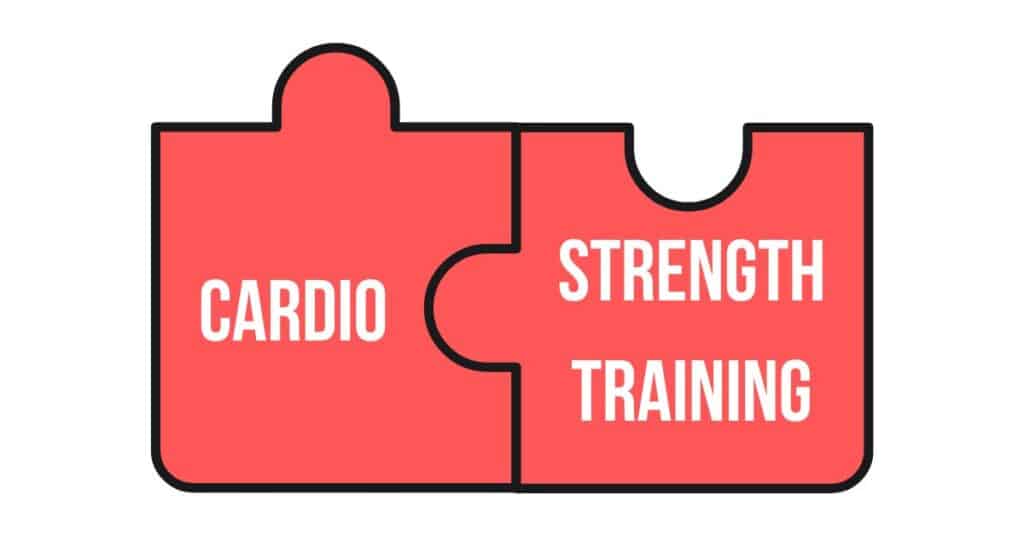Struggling to shed weight and feeling overwhelmed by confusing diet plans? Take a deep breath and ditch the fad diets. The key to unlocking your fitness goals lies not in restrictive eating, but in embracing two powerful tools: cardio and strength training.
This dynamic duo, when used together, works wonders for burning fat and sculpting a healthier you, far exceeding the results of focusing on just one alone.
Scientific evidence backs this claim. A 2017 study by the American Council on Exercise revealed that individuals who combined cardio and strength training achieved a whopping 3 times greater fat loss compared to those who solely relied on cardio (*).
So, ditch the confusion and embrace this winning combination for a transformed physique and a healthier, happier you.
Cardio – Your Calorie-Crushing Companion:

Imagine your body as a furnace burning calories – even when you’re resting. The key to this constant burn? Muscle. The more muscle you have, the more calories you burn during your rest. And building muscle? That’s where cardio comes in.
Don’t worry about becoming bulky. A study by the American Council on Exercise (ACE) found combining cardio and strength training leads to 3 times more fat loss than just cardio alone (*). Here’s why cardio rocks:
- Burns calories directly: Think running, swimming, dancing – anything that gets your heart pumping.
- Boosts your metabolism: After your workout, your body continues burning more calories for up to 48 hours, thanks to this afterburn effect.
- Strengthens your heart and lungs: Leading to a longer, healthier life.
- Boosts mood and energy: Exercise releases endorphins, making you feel energized and happy.
- Cardio is your partner in crime, burning calories during your workout and setting you up for an ongoing calorie-burning advantage. Stay tuned to learn how strength training complements this powerful duo.
Strength Training – Your Metabolic Furnace Booster:

Okay, cardio gets your heart pumping and burns calories while you move. But what about after? Strength training is your answer. Research in the Journal of Strength and Conditioning Research shows it can boost your metabolism for up to 48 hours after your workout (*). Here’s why it’s your secret weapon:
- Muscle burns more calories: Unlike fat, muscle is metabolically active, meaning it burns more calories even at rest. A 2014 study in the American Journal of Clinical Nutrition found that building muscle can increase your resting metabolic rate by up to 15% (*).
- Beyond weight loss: Strength training benefits go beyond the scale. It increases strength and power, improves bone health, and reduces the risk of chronic diseases. A 2018 review in the British Journal of Sports Medicine summarizes these benefits (*).
- Get started easily: Start with bodyweight exercises like squats, lunges, and push-ups. No gym membership is needed.
- Focus on form: Proper form over heavy weights is key to preventing injuries and ensuring effectiveness.
When it comes to strength training, many people wonder whether it’s better to do high reps with lighter weights or low reps with heavier weights. Here’s the solution:
If you’re new to strength training and still getting the hang of exercises, it’s best to start with high reps and lower weights. This helps you get used to using weights and focuses on building a good connection between your mind and muscles.
For intermediate lifters who have some experience, using higher weights can be beneficial for building more strength.
And importantly, if you’re overweight or not in the best shape, opting for higher reps and lower weights is a smart choice. This approach can help you sculpt your body more effectively than lifting heavier weights.
So, the key is to tailor your approach based on your experience level and fitness goals, always focusing on proper form and gradual progress.
The Winning Combination – Cardio & Strength United.

Think of it like this: cardio burns calories during your workout, while strength training keeps your metabolism fired up afterward. Together, they create a powerful fat-burning synergy. A 2013 study published in Medicine & Science in Sports & Exercise found that people who combined cardio and strength training lost 50% more belly fat than those who just did cardio (*).
But wait, there’s more. The benefits extend beyond fat loss:
- Improved endurance: Cardio trains your heart and lungs like a warrior training their stamina.
- Increased strength and power: Tackle everyday tasks with ease and conquer your workout routine like a champ.
- Stronger bones: Strength training helps prevent osteoporosis and keeps your body sturdy.
- Reduced risk of chronic diseases: Both cardio and strength training can lower your risk of heart disease, diabetes, and some cancers.
Ready to unlock your potential? Combine cardio and strength training, personalize your plan, and watch your fitness journey take off.
Beyond the Basics: Tailoring Your Approach
Goals:
- Weight loss: Focus on a balanced approach with slightly more emphasis on cardio (e.g., 3 cardio sessions, 2 strength sessions per week).
- Muscle building: Prioritize strength training (3-4 sessions) while still incorporating some cardio (1-2 sessions) for overall fitness.
- Endurance: Focus on cardio activities like running, swimming, or cycling, while incorporating bodyweight exercises to maintain muscle mass.
Preferences:
- High-intensity vs. low-intensity: Choose workouts you enjoy, whether it’s high-intensity interval training (HIIT) classes or brisk walking. A 2020 study in the International Journal of Sports Medicine found both HIIT and moderate-intensity cardio to be effective for weight loss, so choose what works for you (*).
- Group classes vs. solo workouts: Find what motivates you, whether it’s the energy of a group or the peace of solo sessions. A 2019 review in the Journal of Sport and Health Science suggests that both group and individual exercise can be effective, so choose what keeps you engaged (*).
- Gym vs. home workouts: Utilize equipment or bodyweight exercises based on your access and preference. A 2017 study in the Journal of Strength and Conditioning Research found bodyweight exercises to be just as effective as weight training for beginners, making them a great option for home workouts (*).
Fitness Level:
- Beginner: Start with shorter workouts (20-30 minutes), focusing on mastering basic movements. Gradually increase duration and intensity.
- Intermediate: Aim for moderate-intensity workouts (30-45 minutes), incorporating more challenging exercises.
- Advanced: Push yourself with longer workouts (45+ minutes) and complex exercises.
Crafting Your Personalized Plan:

A. Finding Your Fitness Fit:
- Explore options: From running and dancing to weightlifting and yoga, there’s something for everyone.
- Match activities to your preferences: Consider the time of day, location, and social aspect you enjoy.
- Start small and build gradually: Don’t jump into intense workouts – consistency is key.
B. Sample Workout Schedule:
Remember: This is just a sample, adjust based on your goals, preferences, and fitness level. Include rest days for optimal recovery.
Beginner:
- Monday: 30 minutes cardio (brisk walk) + bodyweight strength training (squats, lunges, push-ups)
- Wednesday: 20 minutes HIIT workout + yoga
- Friday: 30 minutes swimming + bodyweight core exercises
Intermediate:
- Monday: 45 minutes cycling + weightlifting (upper body)
- Tuesday: 30-minutes yoga + bodyweight lower body circuit
- Thursday: HIIT class + swimming
- Saturday: 30-minutes core workout + light stretching
Advanced:
- Monday: 60 minutes running intervals + weightlifting (full body)
- Tuesday: Pilates class + HIIT workout
- Thursday: Crossfit session + yoga
- Sunday: Active recovery (walking, hiking)
Conclusion
Feeling lost in the fitness maze? Forget restrictive diets and complicated routines. The key to unlocking your potential lies in two simple tools: cardio and strength training.
Think of it like this: Cardio burns calories during your workout, while strength training keeps your metabolism fired up even afterward. Together, they become a fat-burning dream team, helping you reach your goals faster.
This guide gives you the basics to personalize your plan. Start small, find activities you enjoy, and gradually increase intensity. Remember, consistency is key. With cardio and strength training on your side, you’ll be well on your way to a healthier, happier you.
Remember, you are the hero of your fitness journey. Cardio and strength training are your loyal companions. Together, you can conquer your goals and achieve a healthier, happier you.


1 thought on “Why Strength Training Is the Fat-Burning Machine You Need?”